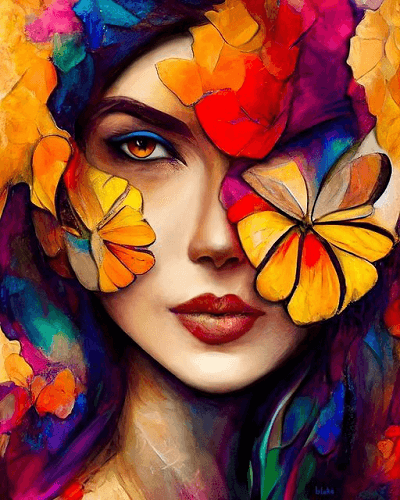Starting an Aesthetic Trip Through the Lyrical Analyses of Nature in Impressionist Landscapes
Each brushstroke, each play of light and shadow, and each shade choice in their works speaks quantities about the artists' deep connection to nature and their ability to convert its elegance onto the canvas. As we check out the lyrical interpretations of nature in Impressionist landscapes, we are invited to immerse ourselves in a world where reality and emotion link, using a look right into the musicians' profound recognition for the natural world.
The Fascinating Brushstrokes of Claude Monet
Claude Monet's proficiency of brushstrokes transcends mere technique, imbuing his landscapes with an aerial high quality that mesmerizes and mesmerizes customers - trump art. His ingenious use color and light, integrated with his distinct brushwork, produces a feeling of movement and life within his paintings. Monet's distinguished collection of jobs illustrating water lilies and his iconic haystacks display his capability to capture the fleeting results of light and atmosphere

Taking On Light and Darkness With Camille Pissarro
Personifying a comparable reverence for the interplay of light and darkness, Camille Pissarro's imaginative vision unravels as an unified exploration of the environment's luminescent subtleties. Pissarro, a crucial figure in the Impressionist movement, masterfully caught the dynamic partnership between light and darkness in his landscapes. His skilled use color and brushwork allowed him to share the subtle changes in light that define various times of day and seasons.
Pissarro's paintings frequently feature spotted sunshine filtering through leaves, casting complex patterns of light and shadow on the earth below. In jobs such as "Hoar Frost, the Result of Snow, Pontoise," Pissarro skillfully depicts the crisp illumination of winter season sunlight compared with the amazing shadows that define the snowy landscape. By embracing both light and darkness in his structures, Pissarro welcomes customers to submerse themselves in the natural charm and transient effects of light worldwide around them.

Via Pissarro's jobs, we are advised of the transformative power of light and shadow, welcoming us to pause and appreciate the fleeting moments of appeal present in the everyday landscapes that border us.
A Symphony of Color Styles by Edgar Degas
Edgar Degas manages a dynamic harmony of colors in his masterful art work, instilling his structures with a dynamic interplay of hues that mesmerize the visitor's look. Understood mainly for his ballet professional dancers and intimate scenes of Parisian life, Degas adeptly controlled shades to communicate state of mind and movement in his paints. trump art. His usage of strong, contrasting shades and subtle tonal variations developed a sense of deepness and vibrancy within his jobs
Degas' shade combination frequently contained abundant blues, deep greens, and cozy oranges, which he applied with certain brushstrokes to catch the essence of his subjects. Whether depicting a ballerina mid-performance or a team of good friends speaking at a cafe, Degas' shades not only illustrated the scene however also stimulated a sense of emotion and power.
Furthermore, Degas' trial and error with light and darkness added an extra layer of intricacy to his color compositions, improving the total atmosphere of his paints (trump art). With his skilled control of shade, Degas developed a visual harmony that proceeds to reverberate with viewers today
Discovering Nature's Peacefulness With Berthe Morisot
Berthe Morisot's creative vision uses a tranquil separation from the vibrant color symphonies of anonymous Edgar Degas, as she catches the serenity of nature in her evocative landscapes. Known for her fragile brushwork and intimate portrayals of everyday life, Morisot's landscapes exude a feeling of tranquility and harmony.
Morisot's paintings frequently include soft, soft tones that communicate a sense of calmness and calmness. Her jobs, such as "The Cradle" and "Summertime's Day," showcase her ability to record the refined beauty of nature in a manner that is both comforting and reflective to the visitor.
Unlike a few of her Impressionist counterparts that concentrated on vibrant make-ups and bold shades, Morisot favored to develop More about the author mild, reflective scenes that invite the customer to reflect and pause. With her skillful use light and darkness, Morisot develops a feeling of peace that resonates with the visitor on a deep emotional level.
The Emotional Landscapes of Vincent Van Gogh
Vincent Van Gogh's landscapes strongly share a depth of feeling with their vibrant brushwork and expressive use of color. The Dutch post-impressionist artist is renowned for his capacity to capture raw and extreme emotions in his paints, transcending standard representations of nature. Van Gogh's troubled personal life, marked by mental wellness struggles, substantially influenced his art, instilling his landscapes with a feeling of anxiousness, sorrowful, or spirit.
In jobs such as "Starry Evening" and "Wheatfield with Crows," Van Gogh's swirling brushstrokes and vibrant shade choices stimulate a profound emotional response from visitors. The stormy skies and agitated landscapes in his paints reflect his internal turmoil and psychological disturbance, welcoming customers to explore the intricacies of his subconscious.
Van Gogh's distinct visual language, characterized by overstated viewpoints and strong use shade, creates landscapes that resonate with visitors on a deeply psychological level. Via his art, Van Gogh invites us to see nature not equally as an exterior reality however as a mirror of our innermost feelings and feelings.
Final Thought
Finally, the impressionist landscapes of artists such as Claude Monet, Camille Pissarro, Edgar Degas, Berthe Morisot, and Vincent Van Gogh offer a distinct and exciting visual analysis of nature. Through this contact form their usage of brushstrokes, light, shade, and feeling, these artists have developed a symphony of images that stimulate a sense of tranquility and charm in the natural globe. Their jobs proceed to influence and enchant customers with their lyrical analyses of the landscapes around us.
Each brushstroke, each play of light and shadow, and each color selection in their jobs speaks volumes about the artists' deep connection to nature and their capacity to translate its elegance onto the canvas. His innovative use of color and light, incorporated with his unique brushwork, creates a sense of motion and life within his paints. His adept use of shade and brushwork permitted him to communicate the subtle changes in light that define different times of day and seasons.

Comments on “Assessing the Social Influence of Trump Art on Modern Artistic Activities”